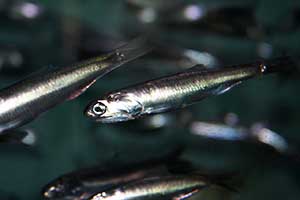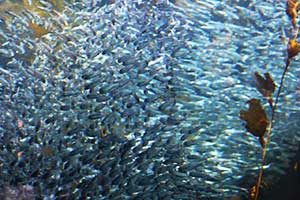Resource Issues: Forage Species
Forage Species
 |
| Northern Anchovy Photo S. Lonhart |
The conversion of sunlight into protein through food webs in the ocean takes many steps. At each intricate step, environmental conditions, predators and fisheries can affect movement of nutrients up the food chain. Forage species are one step in this chain of events and are defined as those species of small fish and invertebrates that feed upon other plankton or small invertebrates, which are then fed upon by larger and often commercially important fish. Forage fish include pacific sardines, herring, mackerel, pacific hake, market squid, juvenile rockfish, anchovy, smelts, silversides, lanternfish, sand lance and krill. These species in turn help to feed tunas and other large pelagic fish, whales, numerous seabirds, turtles, dolphins, sharks, rockfish, pinnipeds, and salmon. A number of species that feed on forage species are threatened or in many cases endangered and rely so heavily on specific forage species that population changes can have dramatic effects.
 |
| School of Anchovies and/or Sardines. Photo S. Lonhart |
Along the central California coastline, encompassing the Monterey Bay, Gulf of the Farallones and Cordell Bank National Marine Sanctuaries, the California Current provides critical habitat for forage species due to increased nutrients from upwelling. Upwelling helps to fuel the food webs of the ocean by providing nutrients that increase the productivity of plankton, which in turn are fed upon by forage species. As fishing pressure increases on larger species, forage species are becoming a target to provide fish for aquaculture feed, livestock and poultry feed, or human consumption. Identifying forage species and working to protect them is being accomplished through the Pacific Fisheries Management Council (PFMC) and the California Department of Fish and Wildlife (CDFW). Both organizations have recently approved plans to start addressing regulations that will prevent the development of new or expanded forage species until Essential Fishery Information is available and applied to ensure the sustainability of target forage species and protection of its benefits as prey.
How is the MBNMS involved?
The MBNMS does not directly manage any aspect of commercial or recreational fisheries. In 2012, the MBNMS' Sanctuary Advisory Council (SAC) received presentations and a “white paper" from the MBNMS' Conservation Working Group (CWG) regarding forage species. An outcome of the presentations and paper was a letter of support to the PFMC, the CDFW, and the CA Fish & Game Commission for each agency's efforts to implement policies that will protect these vitally important species.
Related links:
- MBNMS Conservation Working Group White Paper (Dec 2012)
- MBNMS SAC Final Forage Species Resolution, including California Fish & Game Commission and Pacific Fisheries Management Council policies (Dec 2012)
- MBNMS SAC letters of support for Forage Species Management (Dec 2012)
